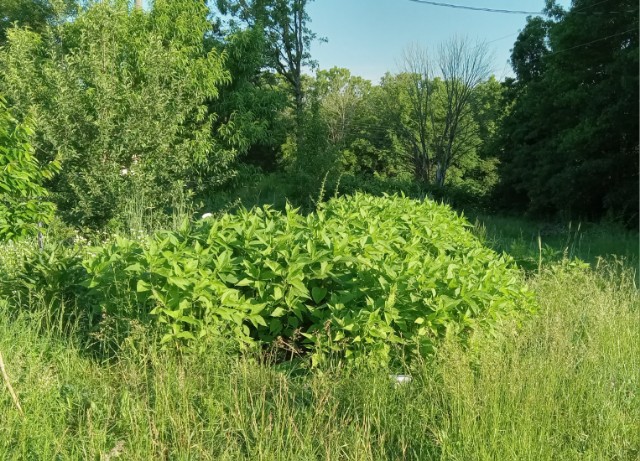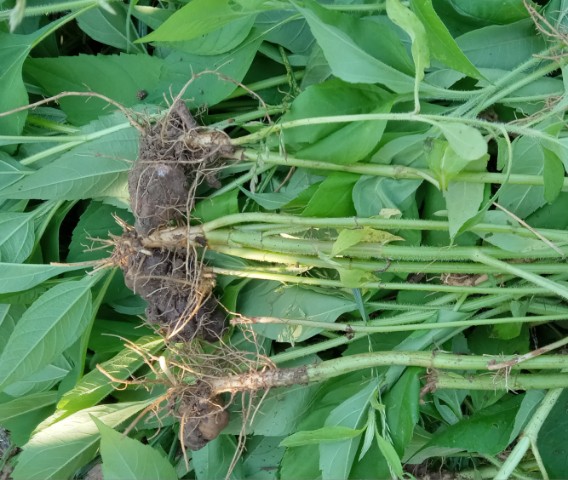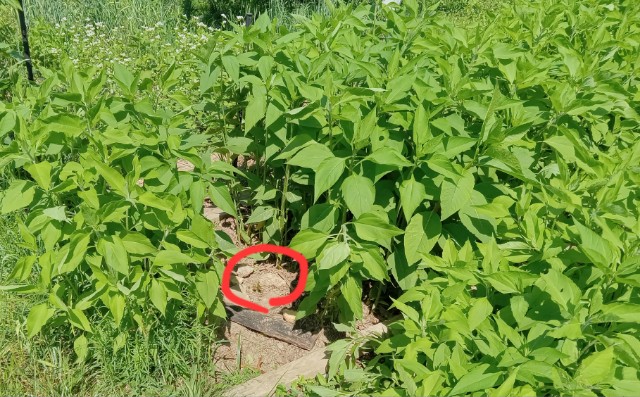
 5
5




Nancy Reading wrote:I'm finding that my woodland sunflower that I planted a few years ago likes it here much better than some varieties of Jerusalem artichoke that I have tried previously - I normally need to leave them in for a few years and get a rather meagre harvest. I wasn't expecting much from the Helianthus strumosus, since most reports suggest that the roots are smaller than H. tuberosa, but they obviously like it here! I planted them in 2021, so this will be their third year, and since it started to look as if they were going to take over the garden (coming up in my pathway) I decided to dig a few to see what I have. Nice! The tubers are long and smooth and perfect, needing just a quick rinse in preparation. These were dug up from just a foot or so of what should be path in the garden. So they produce a fair amount of biomass but no flowers yet, I'm probably just too cool for them. It appears that they will have a tendency for being invasive, so I'll need to be careful where I put them. Mind you the free ranging sheep here will soon stop them spreading too far!
$10.00 is a donation. $1,000 is an investment, $1,000,000 is a purchase.

 6
6




Cécile Stelzer Johnson wrote:And this is your 3rd year, so that is the *natural* shape of the tubers? I sure would like some of those.
Have you grown helianthus [u]tuberosus[/u] before and if you have, how does the taste compare?
It would be interesting to know the kind of soil and growing zone you are in to try and replicate the experiment.
I'm also curious to learn if Helianthus Strombosus give a big yield, if they are closely grouped around the stem [or are 'wanderers'] and how *deep* do they go?
How Permies works: https://permies.com/wiki/34193/permies-works-links-threads
My projects on Skye: The tree field, Growing and landracing, perennial polycultures, "Don't dream it - be it! "
 2
2




 5
5




Try Linux on your computer, free, no virus worries, stable and maintenance free. Distributions I recommend are Linux-Mint and Debian. Better than throwing your PC away when Windows rejects you.
 5
5




Angi Wolverton wrote:Where is everyone getting their tubers? I'm in NW Michigan, and I'd like to try a few varieties that are likely to do well without running too amok! Everywhere that carries them seems to be out. I'm also looking for groundnut/hopniss tubers. Any suggestions? Thanks!
$10.00 is a donation. $1,000 is an investment, $1,000,000 is a purchase.
 6
6







Zone 6, 45 inches precipitation, hard clay soil




 2
2




"The only thing...more expensive than education is ignorance."~Ben Franklin. "We can easily forgive a child who is afraid of the dark; the real tragedy of life is when men are afraid of the light." ~ Plato
 5
5




Gardens in my mind never need water
Castles in the air never have a wet basement
Well made buildings are fractal -- equally intelligent design at every level of detail.
Bright sparks remind others that they too can dance
What I am looking for is looking for me too!

 3
3




 5
5




Try Linux on your computer, free, no virus worries, stable and maintenance free. Distributions I recommend are Linux-Mint and Debian. Better than throwing your PC away when Windows rejects you.
 5
5




Eustace Eugene wrote:This is a weird thing, but I think my sunchokes are under attack by squash vine borers. Has anybody ever seen or heard of that?
$10.00 is a donation. $1,000 is an investment, $1,000,000 is a purchase.
 8
8




 6
6




Sam Shade wrote:Just to say one more tidbit to the mountain of information in this thread, I've had good preliminary results feeding jarts (can't get excited about any other names and the full name is just too long!) to my buff orpington hens.
Don't even have to cook them - just smash the raw tubers with a rock to expose the inner flesh and they go crazy for them.
Very encouraging potential as a ridiculously easy and abundant supplemental winter feed for chickens.
$10.00 is a donation. $1,000 is an investment, $1,000,000 is a purchase.
 4
4




Cécile Stelzer Johnson wrote:
Sam Shade wrote:Just to say one more tidbit to the mountain of information in this thread, I've had good preliminary results feeding jarts (can't get excited about any other names and the full name is just too long!) to my buff orpington hens.
Don't even have to cook them - just smash the raw tubers with a rock to expose the inner flesh and they go crazy for them.
Very encouraging potential as a ridiculously easy and abundant supplemental winter feed for chickens.
I wonder if the 'fartiness' of sunchokes will affect your chooks if you use a lot of them in the feed? Do they lay more or less eggs etc. [The red ones tend to give me colic if I overdo them raw].
 5
5




$10.00 is a donation. $1,000 is an investment, $1,000,000 is a purchase.
 4
4




Cécile Stelzer Johnson wrote:Well, Sam, you gave me plenty of ideas for next year. Root crops do produce in abundance!
Unfortunately, Yacon is unlikely to grow in my zone [4b WI].
As to Chinese yam, it is prohibited here as an invasive plant.[It is my understanding that it would grow, though.]
Raw sweet potatoes. Yum, they grow well here, but much better in raised bed as they do tend to sprawl 6 ft in several directions,, and often 2 ft down[!] They need richer soil than my sandbox, but I got a few nice specimens in raised beds. My chickens prefer them cooked [the little snobs!]. After I work hard to grow these [I grow the Asian sweet potato, with garnet red skin and white inside], I'm loath to share that bounty with them. I had a couple of extra that were thinner, so I didn't cook those, but they jumped at the chance to eat them once they were cooked!
Mangelwurzels are used as fodder in Europe, so I'll try that. I think they should grow wild in my sand, with proper fertilizer. [Also to attract deer, but don't tell the game warden!]
Daikon radish & parsnip are a common food plot mix [again for deer]. I have gone in the field a couple of times to retrieve specimens before the deer season started!
The edible variety of air potato (dioscorea bulbifera) is a really intriguing plant, but in my zone, it's no dice.
Also, the fact that they say *edible* tells me that there is one that isn't.

 8
8




 2
2




Christopher Weeks wrote:I have a boatload of tubers -- this is about 1/4 of my planting but I injured my back in the middle of the harvest and so this is all I got before the ground froze.
Anyway, I left them sitting around for two weeks and they got squishy. I thought about just composting the whole mess of them as we were leaving for a week of holiday travel, but instead, I found a big plastic tub that would barely fit in the fridge, and filled it with the tubers and cold water, put them in the fridge and left them there for nine days. The roots drank up the water so that they weren't entirely immersed and the lid wouldn't close. There's a bit of foam in the water -- signs of microbial action, and some on top went gross. But all in all, they rehydrated well and the ones on the bottom taste good and have the right texture.
So anyway, I'm going through them and peeling and slicing them into a bowl of salt to put them up as a ferment, but it's really slow work. I'm thinking about roasting a big pan of them for dinner but wondering about just washing them and leaving the peel. So I went page by page through this thread searching for peel and reading. It looks like a lot of people peel them, but there are two schools of not doing so: 1) just eat the peel, it's where the flavorful and nutritive compounds are most dense, and 2) cook them in the peel and then at the table, extract the yummy insides with your spoon and leave the emptied peel behind like a sack. So I think that justifies roasting without peeling and trying it both ways on the plate. But I'd be interested to hear any other thoughts people have about their relationship with sunchoke peels.
 3
3




Check out Redhawk's soil series: https://permies.com/wiki/redhawk-soil
 7
7




Susan Doyon wrote:I have loads of these , they make me very gassy ! I have not found a way to cook them that I really love but they are so pretty when in bloom
$10.00 is a donation. $1,000 is an investment, $1,000,000 is a purchase.

 6
6





- Tim's Homestead Journal - Purchase a copy of Building a Better World in Your Backyard - Purchase 6 Decks of Permaculture Cards -
- Purchase 12x Decks of Permaculture Cards - Purchase a copy of the SKIP Book - Purchase 12x copies of Building a Better World in your Backyard
 11
11
















 4
4




 13
13




Zone 6, 45 inches precipitation, hard clay soil




 8
8





|
What did you do today to add joy to the world?
The new kickstarter is now live!
https://www.kickstarter.com/projects/paulwheaton/garden-cards
|





.jpg)
